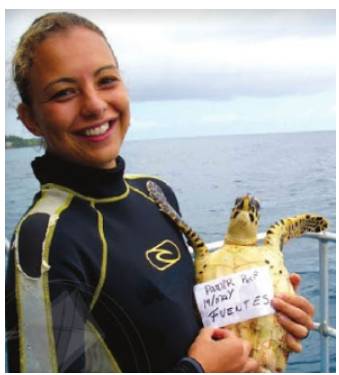Read the following passage and mark the letter A, B, C, or D on your answer sheet to indicate the correct answer to each of the questions from 36 to 42.Sylvia Earle is one of the world's most famous marine scientists and a National Geographic Explorer-inResidence. She loves to go diving in the ocean. She has spent a lot of her life both in and under the waves. Earle has led more than a hundred expeditions and she set a record for solo diving in 1,000-metre deep water. In total, she has spent...
Đọc tiếp
Read the following passage and mark the letter A, B, C, or D on your answer sheet to indicate the correct answer to each of the questions from 36 to 42.
Sylvia Earle is one of the world's most famous marine scientists and a National Geographic Explorer-inResidence. She loves to go diving in the ocean. She has spent a lot of her life both in and under the waves. Earle has led more than a hundred expeditions and she set a record for solo diving in 1,000-metre deep water. In total, she has spent more than 7,000 hours underwater.
Earle describes the first time she went to the ocean: ‘I was three years old and I got knocked over by a wave. The ocean certainly got my attention! It wasn’t frightening, it was thrilling. And since then I have been fascinated by life in the ocean.’
In the past, Earle was the chief scientist of the National Oceanic and Atmospheric Administration in the USA. Now one of her jobs is with Google Earth’s Ocean. Earle’s special focus is on developing a global network of areas on the land and in the ocean. This network will protect and support the living systems that are important to the planet. She explains why this is important: ‘When I first went to the Gulf of Mexico in the 1950s, the sea looked like a blue infinity. It seemed to be too large and too wild to be damaged by the action of people. Then, in a few decades, not thousands of years, the blue wilderness of my childhood disappeared. By the end of the 20th century, about 90 percent of the sharks, tuna, turtles, whales and many other large creatures had disappeared from the Gulf. They had been there for millions of years.’
Some people don’t understand why the ocean is so important to life on Earth. Earle explains that ‘the ocean is the foundation of our life support system. The ocean is alive. The living things in the ocean generate oxygen and take up carbon. If we don‟t have the ocean, we don’t have a planet that works.’
The Gulf of Mexico has had many problems, especially after the Deepwater Horizon Oil disaster of 2010, but Earle says, ‘In 2003 I found positive signs in clear, deep water far from the mouth of the Mississippi River. It was full of life. Large areas of the Gulf are not damaged. Protecting the most important places will be good for the future of the Gulf and for all of us’
Which of these statements describes one of the main points of the article?
A. The marine environment is a key part of all life on Earth
B. The oceans provide us with unlimited resources
C. The sea is one of the most exciting places for science at the moment
D. It is impossible to protect marine areas


1. Mariana studies sea turtles.
(Mariana nghiên cứu về rùa biển.)
2. One of her favorite places is the Torres Strait.
(Một trong những địa điểm yêu thích của cô ấy là eo biển Torres.)
3. She looks after turtles on the beach.
(Cô ấy chăm sóc rùa trên bãi biển.)
Tạm dịch bài đọc:
GIẢI CỨU ĐẠI DƯƠNG
Mariana Fuentos là một Nhà thám hiểm trẻ của National Geographic. Cô ấy nghiên cứu động vật biển, như rùa biển và cá nược. Một trong những địa điểm yêu thích của cô là eo biển Torres gần Australia. Cô chăm sóc những chú rùa trên bãi biển.